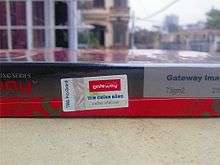Security tape
Security tape (or security label) is a type of adhesive tape used to help reduce shipping losses due to pilfering and reduce tampering or product adulteration. Often it is a pressure sensitive tape or label with special tamper resistant or tamper evident features. It can be used as a ‘’security seal’’ in addition to a package closure or can be used as a security label. They are sometimes used as or with authentication products and can be an anti-pilferage seal.
Security tapes and labels are sometimes used in conjunction with security envelopes.



Use
Security tapes can be used as packaging tapes on small primary packages such as bottles and cartons or on larger shipping containers such as corrugated boxes. They are also used on unit loads or palletized goods. The strength and adhesive bonding are important. Security labels are usually only used for their security features; backing strength is less important but the bonding characteristics are critical.
Some security tapes have an appearance similar to standard packaging tapes to help conceal the value of a pilferable item. Logistics and packaging professionals do not want to bring attention to the item or its package.[1] Other security tapes have bright colors with high impact graphics.
Security tapes and labels are one part of a broader security system: No one layer of security can provide full protection to shipments of packages. Most security products can be foiled by a knowledgeable person with sufficient time and with access to specialized tools, solvents, extreme temperatures, other security tapes and labels, adhesives, etc.
Security tapes and labels usually add security to one point of entry to a container. Other points of unauthorized entry are sometimes available.
Construction
There are many types and constructions of tapes[2][3][4] and labels[5][6] [7] used for security. The use of security printing, holography, embossing, barcodes, RFID chips, etc. is common. Some tape strips and labels have sequential serial numbers, bar codes, etc. Custom printing with corporate logo, etc. is useful but needs to be revised periodically because of creative counterfeiters.
Many security tapes have extra strong backings and high performance adhesives; a damaged or partially open package can be an invitation to theft or tampering. High graphics can draw attention to a package during shipment.
Security tapes often have special features to indicate opening including:
- Intentionally weak or frangible components
- Printing which cannot easily be realigned after a cut or tear
- Layers which easily delaminate, showing entry or removal
- Hidden print layers which indicate opening
- Serrations or perforations to make one-piece removal more difficult
Security tapes are usually wound on a roll (release liner), or a premium release coating is used on the top surface. Security labels are typically die-cut.
See also
References
- ↑ Green, FW (2009), "Export Packaging", in Yam, K L, "Encyclopedia of Packaging Technology", Wiley (published 2010), ISBN 978-0-470-08704-6
- ↑ US 6544615 B2, Otten, Weniger, "Adhesive security tape for detecting unauthorized broaching of a package", published 2003
- ↑ US 4876123 A, Rivera, "Tamper indicating tape and delaminating film therefore", published 1989
- ↑ US 5633058 A, Hoffer, Sobel, "Message-indicating self-wound tape and method of making same", published 1995
- ↑ 5,042,842, Green, Reiss, Wilson, "High Security Label", published 1991
- ↑ US 7594348 B2, Oosterlinck, "Security Label", published 2009
- ↑ US8678289B2, Roseman, "Anti-tamper label and item embodying the same", published 2014